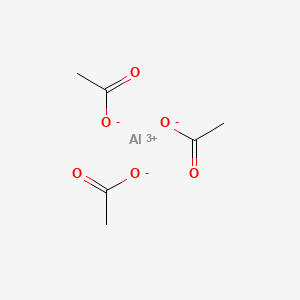
Synopsis
Synopsis
0
API Suppliers
0
USDMF
0
CEP/COS
0
JDMF
0
EU WC
0
KDMF
0
NDC API
0
VMF
0
Listed Suppliers
0
EDQM
0
USP
0
JP
0
Others
0
Canada

0
Australia

0
South Africa

DRUG PRODUCT COMPOSITIONS
0
US Patents
0
US Exclusivities
0
Health Canada Patents
US Medicaid
NA
Annual Reports
NA
Regulatory FDF Prices
NA
0
FDF
0
Stock Recap #PipelineProspector
0
Weekly News Recap #Phispers
0
News #PharmaBuzz


1. Aluminum Acetate Hydrate
2. Basic Aluminum Acetate Hydrate
3. Burow's Solution
4. Domeboro
1. Domeboro
2. 139-12-8
3. Aluminum Triacetate
4. Aluminium Acetate
5. Acetic Acid, Aluminum Salt
6. Aluminum;triacetate
7. Buro-sol
8. Acetic Acid, Aluminum Salt (3:1)
9. 80ehd8i43d
10. Burow Solution
11. Aluminum Acetate Solution
12. Buro-sol Concentrate
13. Hydroxyaluminium Di(acetate)
14. Unii-80ehd8i43d
15. Einecs 205-354-1
16. Aluminium (tri)acetate
17. Aluminium(iii) Triacetate
18. 8006-13-1
19. Aluminum Acetate [ii]
20. Aluminum Acetate [mi]
21. Aluminum Acetate [inci]
22. Aluminum Acetate [vandf]
23. Chembl1201015
24. Dtxsid30890496
25. Aluminium Acetate [mart.]
26. Aluminium Acetate [who-dd]
27. Amy22494
28. Aluminum Acetate [orange Book]
29. Aluminum Acetate [usp Impurity]
30. Db14518
31. Borofair Component Aluminum Acetate
32. Aluminum Acetate Component Of Borofair
33. Q27861942
| Molecular Weight | 204.11 g/mol |
|---|---|
| Molecular Formula | C6H9AlO6 |
| Hydrogen Bond Donor Count | 0 |
| Hydrogen Bond Acceptor Count | 6 |
| Rotatable Bond Count | 0 |
| Exact Mass | 204.0214514 g/mol |
| Monoisotopic Mass | 204.0214514 g/mol |
| Topological Polar Surface Area | 120 Ų |
| Heavy Atom Count | 13 |
| Formal Charge | 0 |
| Complexity | 25.5 |
| Isotope Atom Count | 0 |
| Defined Atom Stereocenter Count | 0 |
| Undefined Atom Stereocenter Count | 0 |
| Defined Bond Stereocenter Count | 0 |
| Undefined Bond Stereocenter Count | 0 |
| Covalently Bonded Unit Count | 4 |
Aluminum Acetate is an astringent. An astrignent is a chemical that tends to shrink or constrict body tissues, usually locally after topical medicinal application. The shrinkage or constriction is through osmotic flow of water (or other fluids) away from the area where the astringent was applied. Astringent medicines cause shrinkage of mucous membranes or exposed tissues and are often used internally to check discharge of blood serum or mucous secretions. This can happen with a sore throat, hemorrhages, diarrhea, or with peptic ulcers. Externally applied astringents, which cause mild coagulation of skin proteins, dry, harden, and protect the skin. Acne sufferers are often advised to use astringents if they have oily skin. Astringents also help heal stretch marks and other scars. Mild astringent solutions are used in the relief of such minor skin irritations as those resulting from superficial cuts, allergies, insect bites, or fungal infections such as athlete's foot.
Related Excipient Companies

Excipients by Applications
Market Place

ABOUT THIS PAGE
34
PharmaCompass offers a list of Aluminum Acetate API manufacturers, exporters & distributors, which can be sorted by GMP, USDMF, JDMF, KDMF, CEP (COS), WC, Price,and more, enabling you to easily find the right Aluminum Acetate manufacturer or Aluminum Acetate supplier for your needs.
Send us enquiries for free, and we will assist you in establishing a direct connection with your preferred Aluminum Acetate manufacturer or Aluminum Acetate supplier.
PharmaCompass also assists you with knowing the Aluminum Acetate API Price utilized in the formulation of products. Aluminum Acetate API Price is not always fixed or binding as the Aluminum Acetate Price is obtained through a variety of data sources. The Aluminum Acetate Price can also vary due to multiple factors, including market conditions, regulatory modifications, or negotiated pricing deals.
A Aluminum Acetate manufacturer is defined as any person or entity involved in the manufacture, preparation, processing, compounding or propagation of Aluminum Acetate, including repackagers and relabelers. The FDA regulates Aluminum Acetate manufacturers to ensure that their products comply with relevant laws and regulations and are safe and effective to use. Aluminum Acetate API Manufacturers are required to adhere to Good Manufacturing Practices (GMP) to ensure that their products are consistently manufactured to meet established quality criteria.
A Aluminum Acetate supplier is an individual or a company that provides Aluminum Acetate active pharmaceutical ingredient (API) or Aluminum Acetate finished formulations upon request. The Aluminum Acetate suppliers may include Aluminum Acetate API manufacturers, exporters, distributors and traders.
Aluminum Acetate Active pharmaceutical ingredient (API) is produced in GMP-certified manufacturing facility.
GMP stands for Good Manufacturing Practices, which is a system used in the pharmaceutical industry to make sure that goods are regularly produced and monitored in accordance with quality standards. The FDA’s current Good Manufacturing Practices requirements are referred to as cGMP or current GMP which indicates that the company follows the most recent GMP specifications. The World Health Organization (WHO) has its own set of GMP guidelines, called the WHO GMP. Different countries can also set their own guidelines for GMP like China (Chinese GMP) or the EU (EU GMP).
PharmaCompass offers a list of Aluminum Acetate GMP manufacturers, exporters & distributors, which can be sorted by USDMF, JDMF, KDMF, CEP (COS), WC, API price, and more, enabling you to easily find the right Aluminum Acetate GMP manufacturer or Aluminum Acetate GMP API supplier for your needs.
A Aluminum Acetate CoA (Certificate of Analysis) is a formal document that attests to Aluminum Acetate's compliance with Aluminum Acetate specifications and serves as a tool for batch-level quality control.
Aluminum Acetate CoA mostly includes findings from lab analyses of a specific batch. For each Aluminum Acetate CoA document that a company creates, the USFDA specifies specific requirements, such as supplier information, material identification, transportation data, evidence of conformity and signature data.
Aluminum Acetate may be tested according to a variety of international standards, such as European Pharmacopoeia (Aluminum Acetate EP), Aluminum Acetate JP (Japanese Pharmacopeia) and the US Pharmacopoeia (Aluminum Acetate USP).
